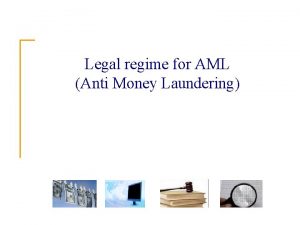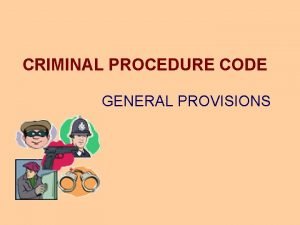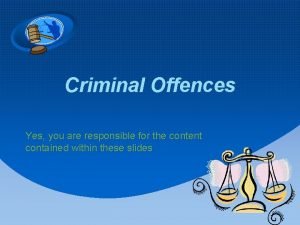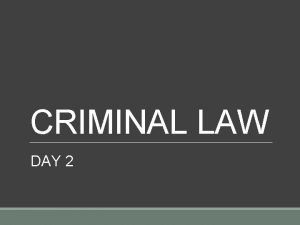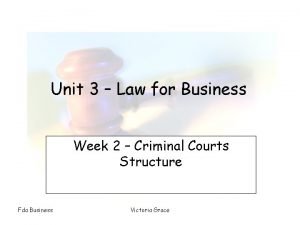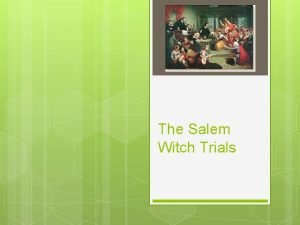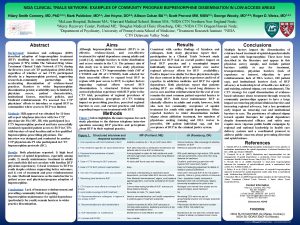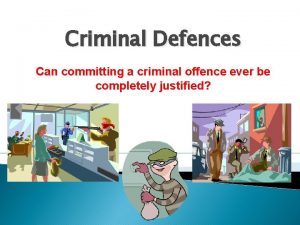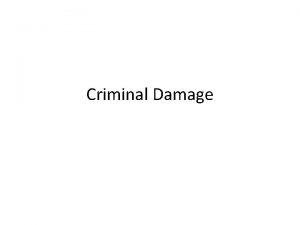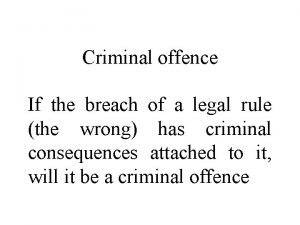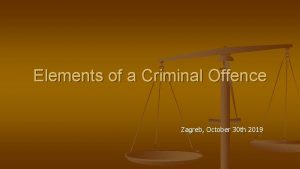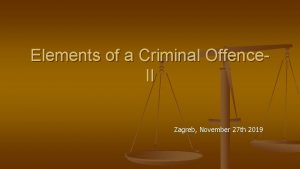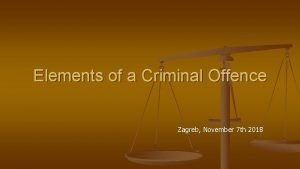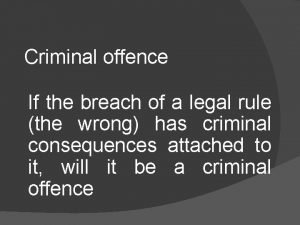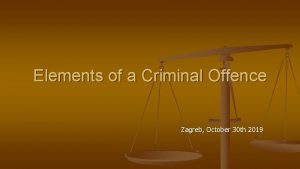CRIMINAL TRIALS 1 Introduction The type of offence














- Slides: 14

CRIMINAL TRIALS 1

Introduction • The type of offence determines which court tries the case • It’s important to know the differences • 1. Magistrates’ Courts • 2. Crown Courts 2

Magistrates • 2 Types : • Lay Magistrates – ordinary members of the public who are then trained. Unpaid (get expenses only) Sit in groups of 3 • District Judges ( Old title – ‘Stipendiaries’ or ‘Stipes’) Legal professionals with 10 years experience. Sit alone. 3

What do Magistrates do? • Hear a variety of cases mostly criminal. • Anyone charged with a criminal offence will be dealt with by Magistrates (unless cautioned by Police) • May try cases completely ( summarily) OR hold committal proceedings where accused will go to Crown Court for trial. 4

SUMMARY TRIAL • Magistrates hear the whole of the case right through to decision on guilt/innocence and then sentence (where accused found guilty) • Convicted person can be sent to Crown Court for sentencing if Magistrates consider it appropriate. • Magistrates have limited sentencing powers – up to 6 months in prison (for one offence) up to 12 months (for consecutive offences) plus other forms of sanction e. g. fines (max £ 5000), probation etc. 5

Crown Courts • Proceedings presided over by judge (Circuit or High Court depending on type of case). High Court judges come from QB Division • Guilt or innocence decided by jury (compare magistrates) • Sentencing by judge • Crown courts hear a very small percentage of criminal trials • Tier system of courts 6

Sentencing • Magistrates have very limited powers of sentencing • Crown Courts have very wide powers but are restricted by any statute creating an offence which lays down sentence that may be passed. • Both courts are bound by the Sentencing Council rules/guidelines 7

Sentencing Council • Created by Coroners & Justice Act 2009. Came into being Spring 2010. • Created to ‘promote greater transparency & consistency in sentencing whilst maintaining the independence of the judiciary. Also aims to inform the public’s understanding of sentencing & help increase public confidence in the Criminal Justice system’ 8

How strict are the rules of the Council? • ‘Any guidelines issued by the council must be followed unless it is not in the interests of justice’ • Look on the Council website for information on the council, it’s members and for guidelines in existence already. • Read Lord Leveson’s speech to Criminal Bar Association in May 2010 9

Problems with sentencing? • Is it too harsh/lenient/OK? • Is it consistent between courts of the same level? A common criticism • How effective was the old ‘Guideline’ system? • How good will the new system be? Read some of the discussion. • Look on SC website and play their game! 10

What about the victim? • The state brings the prosecution (unless it’s a private prosecution e. g. Stephen Lawrence murder) • Victim Support Schemes • Criminal Injuries Compensation scheme – for victims of violent crime – benefits & criticisms • Compensation orders (since 1972) • Criminal Justice Act 2003 – Video links/bail provisions to assist victims & witnesses 11

Domestic Violence, Crime & Victims Act 2004 (1) • Emphasis on the victim • Informing the victim about any trial • Information about when offender may be released – any conditions requested • Commissioner for Administration can investigate complaints re failure to comply with Victims Charter 12

Domestic Violence, Crime & Victims Act (2) • Commissioner for Victims & Witnesses – Role is to promote victim’s interests – Baroness Helen Newlove • To encourage good practice when dealing with victims • Act also provides for Victims Advisory Panel. Consists of voluntary lay people who have direct experience of victimization + senior officials from Criminal Justice agencies + 3 co-opted members from voluntary organisations to which government provides core funding • Impact statements by family members of victims of murder/manslaughter 13

Types of offences • Summary offences e. g. driving offences , some theft e. g. shop-lifting, common assault • Offences ‘triable either way’ e. g. some forms of assault (Actual Bodily Harm), some theft or drug offences - see diagram in Mc. Nae • Indictable Offences – serious crime e. g. murder 14
 Effects of bad manners
Effects of bad manners The supreme court
The supreme court Stages of money laundering process
Stages of money laundering process Predicate offence for money laundering
Predicate offence for money laundering Cognizable offence
Cognizable offence Indictable offence
Indictable offence Indictable offence
Indictable offence Indictable offence
Indictable offence Indictable offence
Indictable offence What is an indictable offence
What is an indictable offence Callow v tillstone
Callow v tillstone Strict liability offence
Strict liability offence Salem witch trials discovery education
Salem witch trials discovery education National geographic salem witch trials
National geographic salem witch trials Nida clinical trial network
Nida clinical trial network


